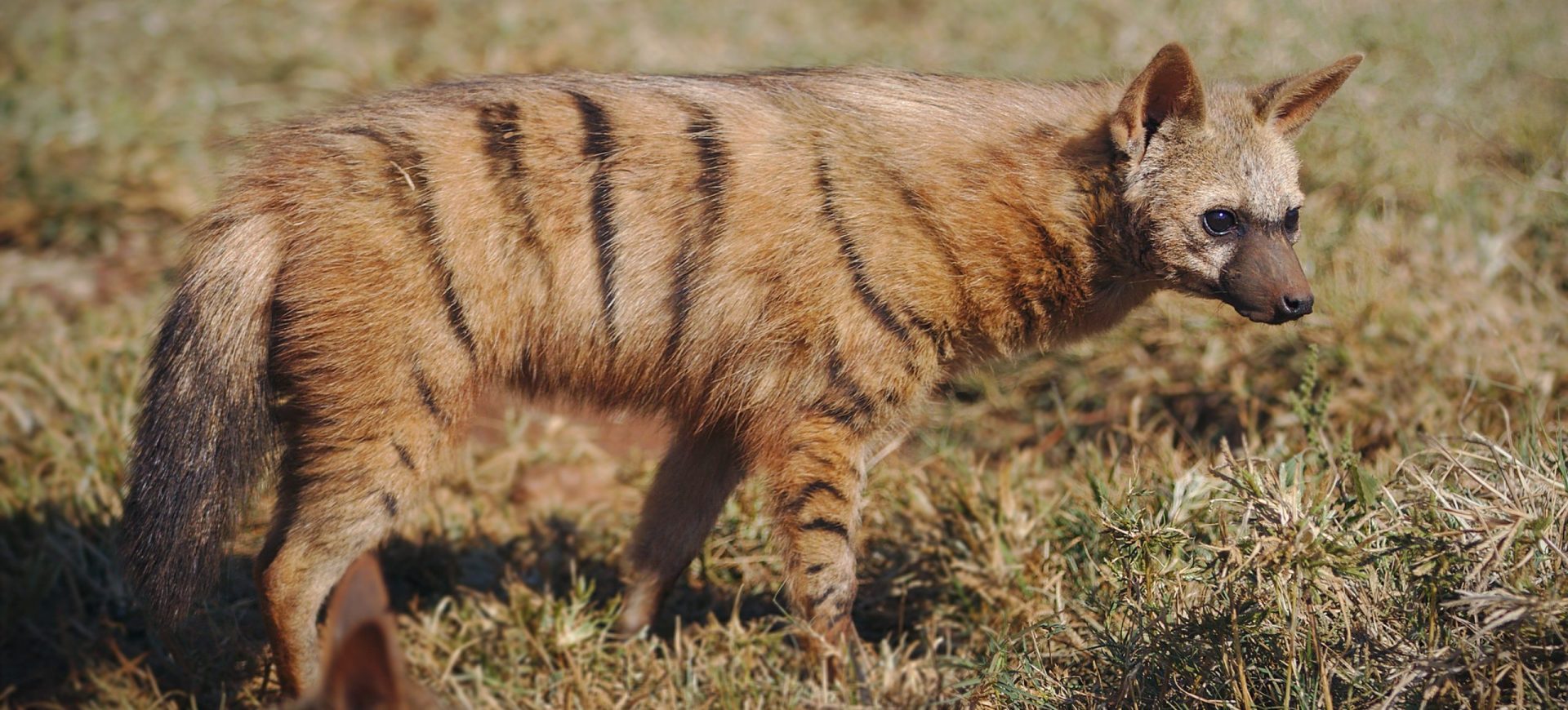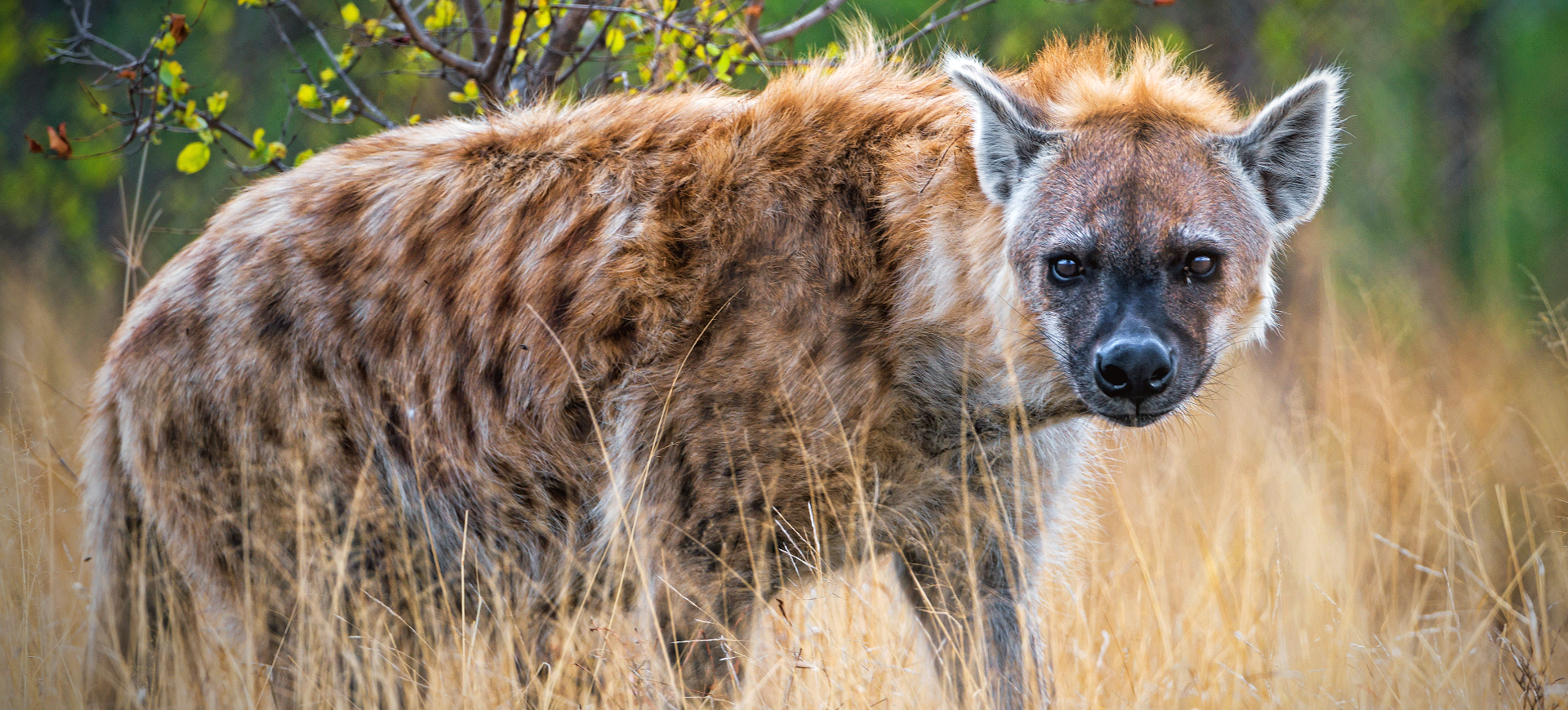Overview
The Striped Hyena (Hyaena hyaena) is a species of hyena native to North and East Africa, the Middle East, the Caucasus, Central Asia, and the Indian subcontinent. Characterized by its distinctive stripes on a greyish coat, a mane that runs down the back, which stands erect when the animal is frightened or agitated, and a relatively bear-like build, this nocturnal scavenger is the smallest of the true hyenas. It possesses a powerful dentition suitable for bone-crushing, complemented by a strong jaw, and is known for its scavenging abilities, often consuming remains left by larger predators. The Striped Hyena leads a primarily solitary life, with individuals or small family groups occupying territories they mark using their anal scent glands.
The Striped Hyena plays a significant ecological role by consuming carcasses, thus preventing the spread of diseases and recycling nutrients back into the ecosystem. Despite their environmental contribution, they are often misunderstood and persecuted due to their scavenging habits and misconceptions about nature. Their elusive behavior, primarily nocturnal activity patterns, and preference for dense brush and arid environments make them difficult to study in the wild. Conservation efforts are crucial for this species, as habitat loss, human-wildlife conflict, and persecution pose significant threats to their populations.
The social structure of Striped Hyenas is complex, involving both solitary and group behaviors, with family units consisting of a mated pair and their offspring. Communication among Striped Hyenas is rich, utilizing vocal sounds, posturing, and scent marking to convey messages regarding territory, reproductive status, and individual identity. They exhibit a high degree of adaptability to varying environments but remain primarily dependent on the availability of carrion and water sources, significantly influencing their distribution and density.
Taxonomy
Kingdom
Phylum
Class
Order
Family
Genus
Species
Sub Species
Type
Physical Description:
The Striped Hyena is distinguished by its coarse, striped fur, primarily grey to straw-colored, with black stripes running over the body and legs and a black throat patch. Adults can measure up to 105 to 115 cm in length, standing about 70-80 cm tall at the shoulder, with a distinctive mane of long hair that stands erect when threatened, adding to its perceived size. This species has a relatively large head with dark eyes, rounded ears, and a powerful jaw equipped with strong teeth capable of crushing bones, a critical adaptation for its scavenging diet.
The tail is bushy, with stripes extending down to the tip, and they possess anal scent glands used for marking territory and communication. The Striped Hyena’s physical adaptations, including its strong forequarters and well-developed neck muscles, are ideal for its scavenging lifestyle, allowing it to drag large carcasses over long distances.

Lifespan: Wild: ~12 years || Captivity: ~23 years

Weight: Male: 57-100 lbs (26-45 kg) || Female: 55-90 lbs (25-41 kg)

Length: Male: 39-47 in (100-120 cm) || Female: 39-47 in (100-120 cm)

Height: Male: 28-31 in (70-80 cm) || Female: 28-31 in (70-80 cm)

Top Speed: 30 mph (48 km/h)
Characteristic:
Native Habitat:
The Striped Hyena inhabits many habitats, including semi-deserts, arid savannahs, grasslands, and mountainous regions with access to water sources. They prefer dense vegetation or rocky landscapes that provide cover and denning opportunities, essential for their nocturnal and secretive lifestyle. Adaptability to different habitats has been key to their survival, allowing them to live near human settlements where they can scavenge for food, although this often leads to conflict.
Their dens are usually located in natural caves or dugouts in sandy or soft soil, sometimes utilizing the abandoned burrows of other animals. These dens are essential for rearing young and provide shelter from predators and extreme weather conditions. The distribution of Striped Hyenas is closely linked to the availability of carrion, their primary food source, which influences their territorial behavior and social organization within these habitats.
Biomes:
Biogeographical Realms:
Countries:
Diet:
Diet & Feeding Habits:
Striped Hyenas are predominantly scavengers, relying heavily on the carcasses of dead animals left by predators, but they will also eat small mammals, birds, insects, and fruits. Their powerful jaws and strong teeth are specially adapted for bone-crushing, allowing them to consume entire carcasses, including bones and hooves, which they can digest efficiently thanks to a highly acidic stomach. This dietary flexibility is crucial to their survival, especially in arid and semi-arid environments where food can be scarce. They hide surplus food in water or bury it under debris for later consumption, demonstrating an understanding of food preservation and storage.
In addition to scavenging, Striped Hyenas occasionally hunt small to medium-sized prey, including rodents, hares, and birds. They are opportunistic feeders that will consume fruit and vegetables, indicating their omnivorous diet. This adaptability in feeding habits allows them to inhabit various environments and reduces competition with larger carnivores. Their role as scavengers helps control the spread of disease by consuming carcasses that could otherwise become breeding grounds for pathogens. Despite their ecological importance, their scavenging nature often conflicts with humans, especially in areas where livestock forms a significant part of their diet.
Mating Behavior:
Mating Description:
Striped hyenas have a complex mating system that is not fully understood but is believed to involve monogamous pairings to some extent. They are generally solitary animals but may come together during the breeding season. Courtship behaviors include vocalizations, scent marking, mutual grooming, and strengthening bonds between mating pairs. The breeding season is not strictly defined and may vary based on geographic location and environmental conditions.
Gestation lasts approximately 90 to 92 days, culminating in the birth of 1 to 4 cubs. The cubs are born in dens and are cared for by both parents, although the female primarily undertakes nursing and rearing duties. The young are weaned at around 8 to 12 months but may remain with the mother for up to 20 months, learning survival skills and social behaviors. This extended parental care ensures that the cubs are well-prepared for independent life.
Reproduction Season:
Birth Type:
Pregnancy Duration:
Female Name:
Male Name:
Baby Name:
Social Structure Description:
A balance between solitary and social behaviors characterizes the social structure of striped hyenas. While primarily solitary, especially when foraging, they exhibit complex social interactions within their kind, particularly during the mating season and when raising young. Scent markings mark territories, and a hierarchy governs access to resources and mating opportunities. Family units, consisting of mated pairs and their offspring, may share a den and foraging areas.
Research suggests that striped hyenas have a more flexible social structure than previously thought, with individuals forming temporary alliances or groups for specific purposes, such as defending territories or accessing abundant food sources. This adaptability may be key to their survival in varied and changing environments. The extent and nature of their social interactions continue to be studied, revealing more about their complex behaviors and ecological roles.
Groups:
Conservation Status:
Population Trend:
The global population of striped hyenas is difficult to estimate accurately due to their nocturnal nature and the wide range of habitats they occupy. In many parts of their range, populations are declining, primarily due to habitat loss, road accidents, and human persecution. These animals are often targeted for their perceived threat to livestock despite their scavenger diet and beneficial role in ecosystem health by consuming carrion and controlling pest populations.
Conservation measures are hampered by a lack of comprehensive data on their numbers and distribution, making it challenging to implement effective protection strategies. In some areas, local conservation programs are working to mitigate human-hyena conflicts and promote coexistence through education and protective measures for livestock. The fragmented nature of their populations, coupled with their wide range, requires a coordinated approach to conservation that addresses the specific threats they face in different regions.
Population Threats:
The main threats to striped hyenas include habitat loss due to agricultural expansion, urbanization, and infrastructure development, fragmenting their living spaces and reducing access to food. Persecution by humans, often due to misconceptions about their nature and the exaggerated threat they pose to livestock, also significantly impacts their numbers. In addition, road accidents are a major cause of mortality in areas where their habitats intersect with road networks.
Poisoning, intentional and accidental, from consuming bait left for other predators presents a significant risk. Additionally, competition for food with other large carnivores and the impact of climate change on their arid and semi-arid habitats could further threaten their survival. These cumulative pressures necessitate urgent and targeted conservation efforts to ensure the striped hyena’s continued presence in the wild.
Conservation Efforts:
Conservation efforts for striped hyenas include habitat protection, research to better understand their ecology and behavior, and initiatives to mitigate human-wildlife conflicts. Protected areas provide crucial refuges where hyenas can live with minimal human interference. Education programs aimed at local communities help change perceptions of hyenas, highlighting their role in the ecosystem and reducing instances of persecution.
Efforts to secure food sources and manage waste can also reduce the likelihood of hyenas coming into conflict with humans. Some regions have implemented road signage and wildlife crossings to prevent road accidents. International collaboration is essential, given the striped hyena’s wide range and the cross-border nature of many threats they face. Despite these efforts, there is a need for increased global awareness and support for striped hyena conservation to address the challenges they face effectively.
Additional Resources:
Fun Facts
- Striped hyenas can eat up to a third of their body weight in one meal.
- They can produce a variety of vocalizations but are less vocal than spotted hyenas.
- Unlike other hyena species, striped hyenas have a mane that can stand erect when the animal is frightened or excited.
- Their powerful jaws and strong teeth allow them to crush bones easily.
- Striped hyenas practice “food caching,” hiding surplus food in water to consume later.
- They have been depicted in Middle Eastern and African folklore and mythology as symbols of treachery and stupidity.
- Striped hyenas are one of the few mammalian species known to perform pseudo-penis presentation, a behavior observed in females.
- Their digestive system can neutralize bacteria found in carrion, preventing disease.
- Striped hyenas often use abandoned aardvark, fox, or warthog dens instead of digging their own.
- They can swim and cross water bodies for food or new territories.













